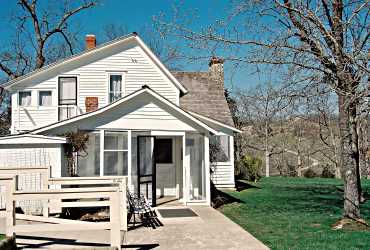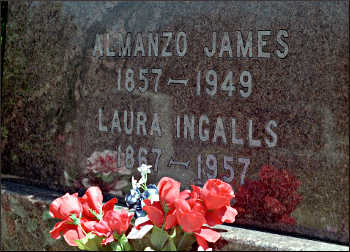The last Little House
Laura Ingalls Wilder's home in rural Missouri was the final stop on a famously winding path.

© Beth Gauper
Mansfield, Mo., has never been a particularly prosperous town. Lying in the heart of the Ozarks, its landscape is bucolic but barely fertile.
In 1894, however, a stream of people seeking better lives was flowing through this Gem City of the Ozarks, and among them was 27-year-old Laura Ingalls Wilder, who had traveled in a horse-drawn hack from De Smet, S.D., with her husband, Almanzo, and their daughter, Rose.
As a child, Laura had zigzagged across the Upper Midwest with her family, dogged by failure. Her life with Almanzo seemed similarly destined: Two years after they married, their barn barned.
The next year, they contracted diphtheria, and Almanzo suffered a stroke that crippled him for life.
The year after that, their infant son died. Their house burned down and their crops failed. They moved to Florida, then back to De Smet.
When they had saved $100, they left for the Land of the Big Red Apple. It was on a new rail line and had a flour mill, two general stores, two drugstores, two churches, a school and a bank.
They bought a parcel of rocky land on a ridge a mile east of town and began scraping together a living.
Almanzo sold firewood in town and carted people and freight from the depot. Laura cooked meals for men working on the railroad. They raised apples, beans, sheep, goats, cows and hens. Laura became renowned for having hens that lay eggs in winter, when no others would.
But they never had much until, at age 65, Laura published "Little House in the Big Woods," following it with the eight other books in what became the famous children's series.
They were all written in Mansfield at what Laura called Rocky Ridge Farm, the final stop on a pilgrimage route that stretches from Pepin, Wis., to Walnut Grove, Minn., Burr Oak, Iowa, and De Smet, S.D.
Since Laura's death in 1957, fans have streamed into the town of 1,400 to see the house, the town and the cemetery where Laura, Almanzo and Rose are buried. Mansfield no longer is known for the shining apples that drew hopeful settlers a century ago.
But the town still fills with tourists, especially for the outdoor pageant in July and August and Wilder Days in September.
For Laura fans, this is where the treasure is. Laura lived to be 90, and family heirlooms and memorabilia ended up in the museum adjoining her house — the family Bible, with birth dates entered in flowing script; and Laura's and Mary's school slates, for which Pa eked out money in "On the Banks of Plum Creek."

© Beth Gauper
There's the calling card of Nellie Owens, whom Laura called Nellie Oleson in her books, and Laura's teaching certificate.
And then there's the item everyone wants to see — Pa's fiddle, whose merry tunes Laura carried in a cherished refrain from book to book.
When we were there one spring day, the museum's guest book filled with names of visitors from half a dozen states within an hour. Grown women were oohing and aahing over the battered fiddle — "Pa actually played this for Mary and Laura," they told their daughters reverently.
In one corner, two little girls walked from Ma's pearl-handled pen to a crazy quilt, their long black braids and ankle-length plaid flannel dresses swishing. It's their everyday attire, said their mother, Charmaine Schafernak of Libertyville, Ill.
"Ever since they were little, I don't know why, they've been like this," she said. "If we could turn the clock back for them, they'd love that."
In the house, Hazel Freeman was starting a tour in Laura's bright-yellow kitchen, which has a window through which Laura looked when she was doing tedious chores. The kitchen felt like a child's playhouse.
"Laura was a tiny little lady; that's why the counters are so low," Freeman told us.
Once, the kitchen was the couple's entire house. Almanzo added small rooms one by one between 1896 and 1913, each with low ceilings and sloping floors.
In the dining room, there's the spindled rocking chair in which Laura answered mail, and a pile of birthday greetings Laura received a few days before her death.
The parlor includes a fireplace made not from brick but from three huge slabs of stone from the farm, on which Laura insisted ("For the only time in my life, I made use of a woman's time-honored weapon, tears").
There's Laura's narrow, bright-green bedroom, adorned with prints from a Currier & Ives calendar, and the adjoining study with the secretary desk at which she wrote when she couldn't sleep.
It's all preserved as it was in the 1940s and '50s, along with the pastoral views from the many windows, which Laura loved. She called them her "pictures."
"She has windows everywhere," wrote her daughter, Rose, "not only in her house, but in her mind."
Trip Tips: Laura in Mansfield, Missouri
Getting there: Mansfield is in south-central Missouri, 70 miles northeast of Branson and 50 miles east of Springfield.
It's particularly pleasant in spring.
Laura Ingalls Wilder Historic Home: It's open from March 1 through Nov. 15.
Events: In Mansfield's city park, the Ozark Mountain Players present the play set in 1951, from late August through September. There are no reserved seats but no shortage of places.
Laura Ingalls Wilder Days is in mid-September and includes pony rides, storytelling, old-time music, various contests and a parade with covered wagons. Reserve accommodations early.
Springfield is 50 miles west and has many inns, motels and B&Bs, 800-678-8767. Branson is 75 miles to the southwest.
Background: The slim volume "On the Way Home" is Laura's diary of the family's 1894 journey to Mansfield, with lively additions by Rose Wilder Lane, a journalist and author who achieved fame in her own right.